Does Performance Management Really Help Every Employee Become Their Best Self?
I’m about to introduce you to a proven methodology called Best-Self Management, that has led to unbelievable success at my company, and for every employee. By building a work culture and instituting practices that supported each person in being and becoming their best self, high performance and uncommon loyalty resulted naturally across the board. But first it’s important for you to understand how I got here.
I graduated from college twenty years ago with a degree in computer engineering and the dream of starting a company of my own, but didn’t feel like I was ready and wanted to get some “experience.” I was recruited by a 7,000 person public consulting firm and then quickly relegated to what I called “beige cubicle land.” I was working ten to eleven hour days from a windowless computer lab in Roseland, NJ, doing work that I described as “soul-crushing.”
In hindsight, I now realize that it wasn’t the work itself, nor the environment that were to blame, but it was the poor organizational culture and the lack of context that was given to me about my work. How did my work impact the company, the world, anyone?
It was that experience that propelled me into entrepreneurship earlier than I’d expected, so in the summer of 1999, I co-founded an ad-tech company in NYC and was on my way! But after the initial excitement wore off, I once again found myself struggling. I wasn’t producing the results I had hoped for, and I felt this sense of emptiness about the products and services we were building for our customers.
This launched me into a near decade long inquiry and exploration where I studied everything I could get my hands on, from productivity to psychology (and everything in between) and attended seminars ranging from personal development to business. While I may not have been consciously aware of it at the time, what I was really seeking was a sense of meaning & purpose, I was seeking to become my best self.
So when it came time to start my next company, I realized that my purpose was to support people in being and becoming their best selves. At the outset, I asked these questions: What if we built a company whose sole purpose was unlocking the potential of the people in it? What if our product was designed to help unlock the potential of each person at the organizations we served? Wouldn’t that lead to uncommonly high performance and loyalty?
From that question, 15Five was born. Today, we are at the forefront of a new category of software that helps leaders and managers drive high performance by bringing out the best in their people (commonly referred to as continuous performance management).
I attribute all of our success to the questions we asked at the outset, the culture we designed which resulted from that inquiry, and the leadership and management practices we’ve put in place over the life of the company. Based on our success to date, I now feel very confident that we’re on to something, and ready to start sharing our learnings more broadly with the world.
The employee retention dilemma
If you own a business, you probably assume that attrition is a regrettable but inevitable fact of life. In fact, you’ve probably lost at least one employee this year. Well, some attrition may be unavoidable but considering average overall turnover is 18% (and the average cost to replace an employee approaches $7k), that number is way too high.
Most companies struggle to attract, retain, and maximize their people, because they’ve been looking in the wrong direction and focusing on the wrong things. It’s an innocent mistake. Most organizations simply do what’s always been done, and while that may have been effective and made sense at that time, they are no longer useful for the times we live in now.
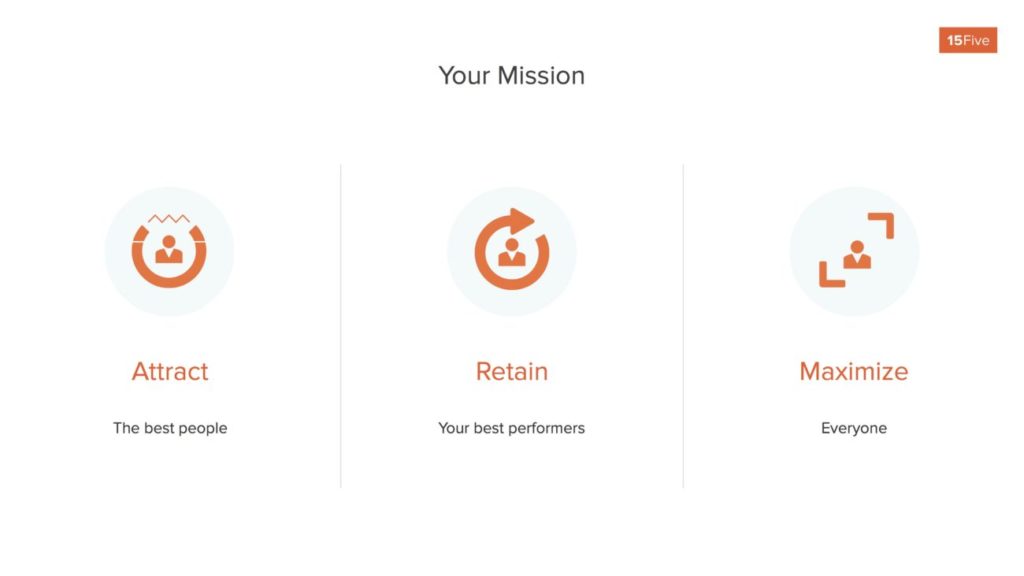
Businesses are very adept at tracking their CLTV (Customer Lifetime Value), which is a factor of how much revenue a customer contributes over what length of time. This is important when your CAC (Customer Acquisition Cost) is fixed, and you’re trying to produce an adequate return.
So why don’t more businesses track the value of their employees? One of the tools I often share is the concept of ELTV or Employee Lifetime Value. For an excellent explanation of ELTV, read How to Understand the ROI of Investing in People: Using Employee Lifetime Value to Articulate the Business Impact of Your People Team
Like with CLTV, we all have fixed and sunk costs for recruiting each new employee. Each time someone leaves, there’s a disruption to the business while we have to go out and recruit a replacement, and negative value that’s being created if there’s any gap before we find that replacement and while they’re ramping up. What if we were able to shorten the time to ramp, increase the contribution each person is able to make during their tenure, and retain them much, much longer? I believe that not only is this possible, but the very same thing that would have someone contribute more is what has them want to stick around longer.
During the industrial era, it was leadership and management who added strategic design and operational value, and what organizations needed was hard working, cheap labor who would follow the script, and who were more or less replaceable. But the environment is now dramatically different. Josh Bersin, a key analyst in the HR technology space recently summed it up by saying, “Today more than 85% of stock market capitalization is intellectual property, brand, services, and software so every person matters.”
In today’s world, the people in organizations who are creating that intellectual property and software, and the people who are delivering the services and representing the brand with everything they produce and every customer they touch, are the company’s individual contributors. It’s the companies who create extraordinary intellectual property, software, services and brands who succeed in this environment, and extraordinary doesn’t happen by following a script.
The world of work has changed dramatically and the most commonly practiced methods of leadership and management haven’t kept pace. Those practices are not merely ineffective, but have become increasingly counterproductive at producing the level of high performance and engagement companies are striving so hard to achieve.
Unlike the industrial era where the interests of organizations were at odds with those individual contributors (which is why in many cases unions were required to create balance in a power dynamic where organizations often had the upper hand), what organizations need most from their people are now completely aligned with what those same people want for themselves — an opportunity to work in an environment where they can truly thrive and put their unique strengths and talents to work in service of a mission they believe in.
It occurs to me that we’ve entered an age where employers and employees can be in true partnership, on the same side of the table vs. at odds with one another, in creating a truly win-win relationship where both the employee and employer thrive, rather than one side winning at the expense of the other.
You’ll hear a lot of people today talk about how we need to invert the typical org chart, and this is exactly why. Leaders and managers now need to be in service to the people they direct, not the other way around. However to fully realize this, we need to take an entirely different and new approach to both leadership and management.
The modern management secret
I’m now going to share a secret with you that my co-founders and I have discovered after running a 6+ year experiment inside of 15Five, that proves helping every employee become their best self works for their benefit as well as the financial success of the company. Today we’re a company of nearly 80 people and have only had four people voluntarily leave in our company’s history. We’ve been extraordinarily capital efficient, and based on a reputable benchmark, we were recently producing about 2x the average revenue per employee of companies at a similar size and stage. In 2018 we nearly doubled our annual recurring revenue while burning very little cash, and secured over $8Million in Series-A financing.
So what exactly do I mean by “best self”?
I find it’s helpful to illustrate it in contrast to what it’s not. Some things you might notice when someone is being their best self are that they exhibit extraordinary performance vs. average or mediocre performance. They’re engaged in learning and growing vs. drama and politics.
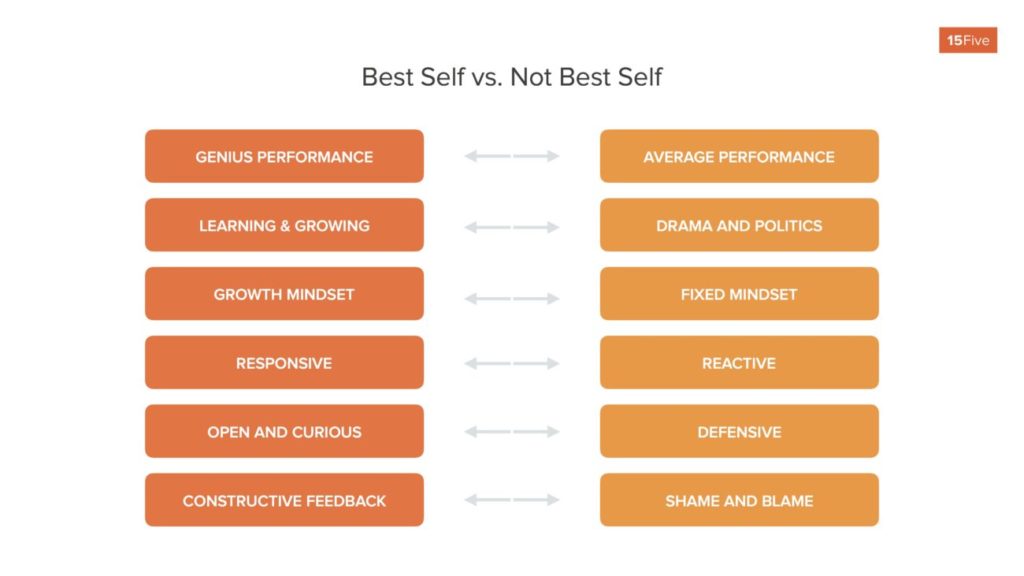
Further, there are a number of universal characteristics people exhibit when they’re being their best self:
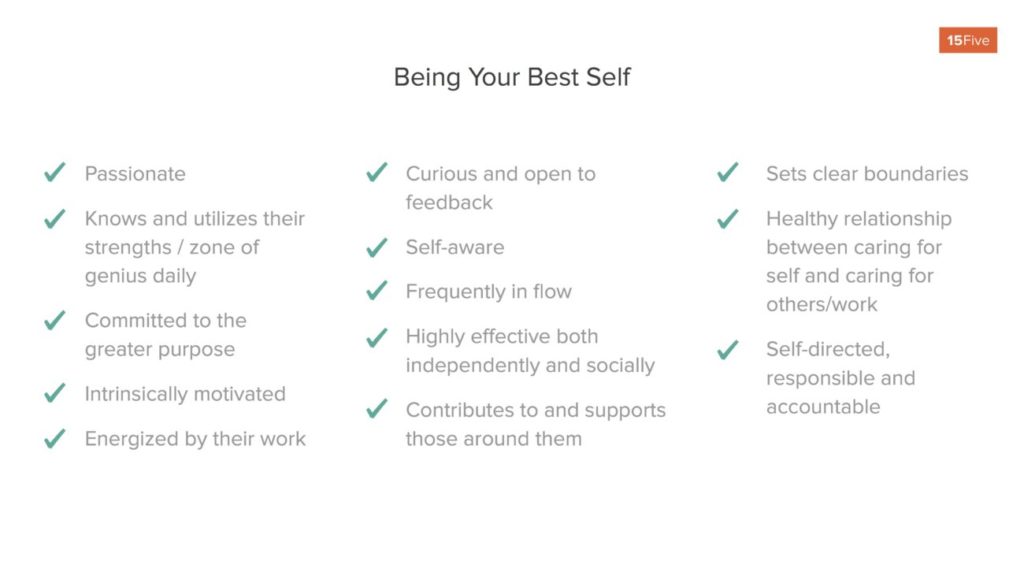
Just as a plant or tree will naturally grow into its full potential if given the right conditions for its unique nature (e.g. soil, altitude, air, water, sunlight, etc.), so will a human being naturally grow into his or her full potential if given the right conditions and environment. It’s literally built into our nature. That innate desire, no matter how seemingly buried it might be, is also why I believe we’re drawn to thought leaders and their messages like, Simon Sinek’s Start With Why or Brené Brown’s The Power of Vulnerability.
So what does it take to actually put this into action? First, there are a few key distinctions that I think are important to grasp, as well as a few important (but non exhaustive) concepts related to human growth and potential. Finally, you’ll need a high-level leadership strategy as well as specific practices that all managers/coaches should engage in in your organization. Let’s start with the distinctions.
Image you were an alien who came to planet earth, and you came across this apple tree in a clearing, rife with apples. After eating all the apples, you might think to yourself, “I’d really like more apples!” Now besides the fact that it’s obvious to you and me that we’ll likely need to wait for some period of time before the tree bears more fruit, the most important factors that go into whether that tree will thrive and produce more apples are largely invisible.
There’s a root system under the ground that needs to be nourished. The tree needs adequate sunlight and water. Without an understanding of these things, which would be non-obvious if you just happened across a tree for the first time, you’d likely be hacking away at the leaves and branches and making very little progress toward getting the fruit you’re after.
I actually think that most traditional performance management (and management in general) practices are similar. They’re missing the essential understanding of what keys drive human growth, potential, and ultimately performance. Instead, we’re out there hacking away at the leaves and branches hoping to get the result we’re after. So the first distinction, very much related to the analogy above, is that every individual and every group of people have both a being state (which is largely internal/invisible) and a doing state (which is largely external/visible).
High performance is a result or an outcome, not something that can be managed directly; it’s a byproduct of focusing on other things that give rise to it. Therefore if you’re practicing “performance management” you’re already trying to manage the wrong thing. (In other words, if you want more apples, focus on the roots and not the branches.)
Or you can think about it from the perspective of sports. Once a player or athlete is on the court or the field, there’s not all that much management of their performance you can do. It’s everything that player/athlete has done leading up to it that will by and large determine how well they will perform. In business, it’s no different.
If you shouldn’t be doing Performance Management, what should you be doing?
The answer to that question is to instead focus on Best-Self Management. By supporting people in being and becoming their best selves, higher and ever increasing performance becomes a natural by-product, not to mention uncommon levels of passion, commitment, and loyalty — qualities less and less often associated with the average person’s experience of work.
This management philosophy and methodology allows you to address the hidden factors that stimulate sustainable growth and development in each employee to in turn help your company become far more successful than you had ever thought possible. Because today what organizations need most are people who are tapped into their greatest gifts and strengths, who are passionate, committed to the mission, loyal and who are able to express genius-level performance through their work. These people are anything but easily replaceable.
We define Best-Self Management in two parts. First, it’s about creating a culture that brings out the best in who your people are today. This is an important distinction, because there’s nowhere anyone needs to get to. Your people are already great. They have natural talents and strengths, and positive qualities that can be more readily expressed given the right environment.
Second, it’s about supporting people in learning, growing, developing, evolving and becoming their best over time. We’re all works in progress. We all have a unique set of talents, passions and perspectives. When we take the time to understand what those are, and give someone the opportunity to align their work with those talents and passions such that they’re able to make the greatest contribution possible, they can’t help but grow quickly.
Now before you jump to thinking this is some airy, soft style of leadership, let me put this in context. I often hear companies in Silicon Valley debating about whether they’re a Sports Team or a Family. For example, Reed Hastings of Netflix often speaks about how they made the conscious decision that they’re a Sports Team.
Each of these metaphors has pros and cons, but in general, the Family tends to prioritize relationships over results, and the Sports Team prioritizes results over relationships. I personally don’t believe we need to choose, and that we can both radically care for the people in our organizations while radically caring about performance and results as well.
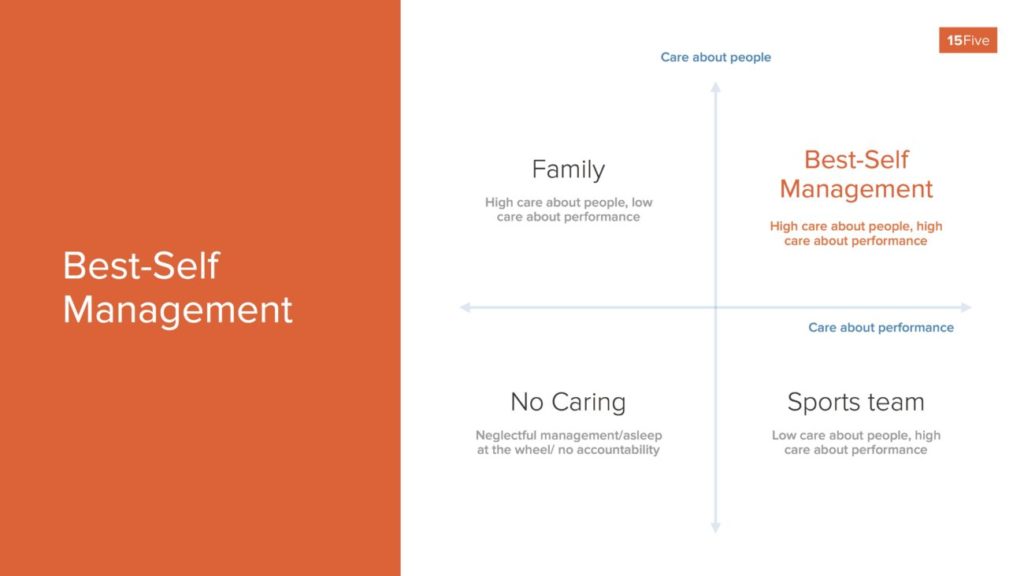
A great example of this comes from one of our top salespeople, Allison. Allison came to us as a single mother of a four year old, who didn’t feel much loyalty to a former employer because they made it fairly difficult for her when she was having her first child. While at 15Five, she met a new partner and decided to have a second child. We believe that having a child and integrating them into a family is a massive endeavor and the standard practices in terms of family leave in the U.S. are seriously inadequate.
Even though we’re a young company, we offer up to a full four months of paid leave so that our employees are able to truly take care of themselves and their families. Allison was our first salesperson to take this leave, so I discussed with our CRO how we would handle compensation during that time. It didn’t seem fair to just pay her the base salary, as that would be half or even less of what she typically earned and might create a financial hardship.
Instead, I suggested that we take the average of the commission she typically produces from the prior few quarters and pay her that. That way she’d have the peace of mind that her income was stable during her time away. She was the top producing salesperson in Q3, hitting 230% of quota, and shared this High Five (which I’m re-sharing with her permission) to me, our CRO, and Chief Culture Officer via our own tool 15Five:
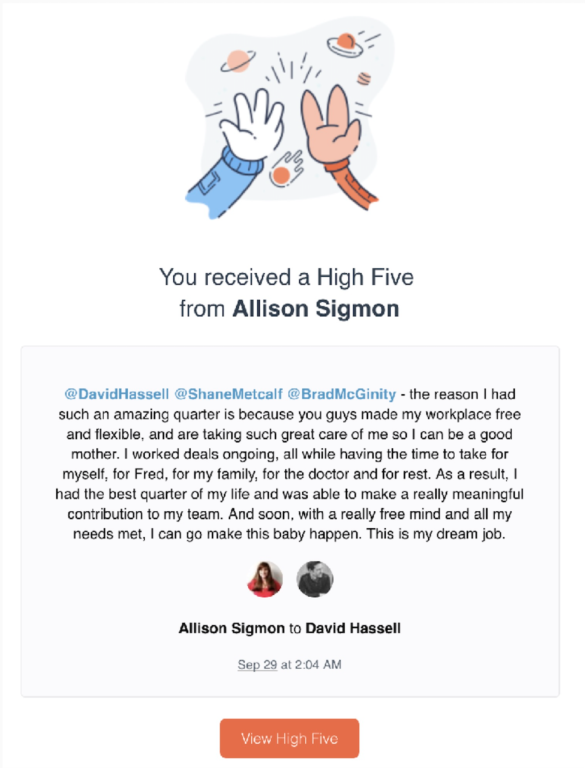
This is a massively different experience for Allison than she had at her former employer. If I had to guess, I’d bet she’s going to come back even stronger and more loyal after her leave, and we’ll get to benefit from her brilliant determination, skill and drive as a top performing salesperson for 15Five for a long time to come.
What does it take to actually put Best-Self Management into action?
Read part two for 5 Key Management Practices you use to start facilitating every employee at your organization becoming their best self.
 David Hassell is cofounder and CEO of 15Five, performance management software that includes continuous feedback, OKRs, peer recognition, 1-on-1s, and 360° reviews. David speaks and writes about leadership and was named “The Most Connected Man You Don’t Know in Silicon Valley” by Forbes Magazine. Follow him @dhassell.
David Hassell is cofounder and CEO of 15Five, performance management software that includes continuous feedback, OKRs, peer recognition, 1-on-1s, and 360° reviews. David speaks and writes about leadership and was named “The Most Connected Man You Don’t Know in Silicon Valley” by Forbes Magazine. Follow him @dhassell.
Image Credit: Tommy Lisbin on Unsplash




